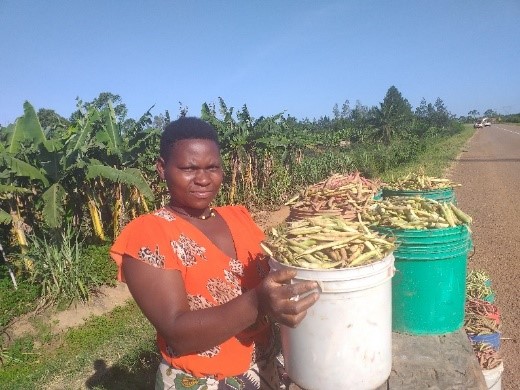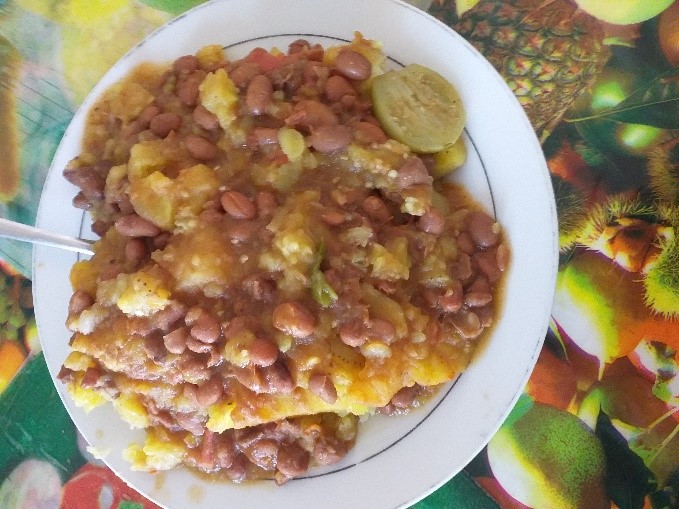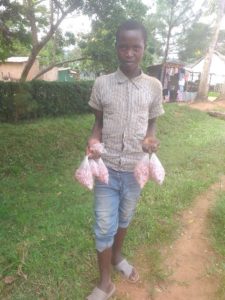By Fadhili Kasubiri, Sylvia Kalemera, Kessy Radegunda, Eileen Nchanji, Owen Kimani, Patricia Onyango & Jean Claude Rubyogo
Beans are a staple food in most rural households in Tanzania. They are both a food and income-generating crop in most households. Kagera region is one of the leading producers of common beans in Tanzania. The most popular traditional dish in the area is beans mixed with banana locally known as ’matoke’ accompanied with some vegetables.
Fresh beans grain ‘’maharage mabichi’’ business is gaining popularity in the region because they cook faster and are very tasty. According to Ms. Grace Kaishozi, a famous fresh bean grain wholesaler at Bukoba’s main food market, most people are now eating more fresh beans because they cook faster compared to dry beans (usually take more time- up to two hours) thus they require less energy to cook. There is a big challenge of getting fuel to cook.
“Our main source of fuel is charcoal and it has increasingly become too expensive to buy. The price has hiked recently because it is not readily available posing a big challenge to use, which is why people buy fresh beans because of the short cooking time,” said Ms. Kaishozi. Thus, the short cooking time conserves fuel.
Most of the vendors are young men and women who hawk the fresh beans to buyers. These young people are either sent by their parents or hired by the sellers at a fee to look for buyers to have bought the beans.
“I get paid Tsh. 200 (US 0.09) for each sack of 0.5kg of peeled fresh bean I sell to a customer and Tsh. 100 (US 0.045) for an unpeeled one. I can sell up to 15 sacks a day and get a good income,” says George Ibrahim, one of the fresh beans business hawkers.
Wholesaler and retailer of the fresh beans source it from the nearby district in Missenyi. The farmers grow different bean varieties along the Kagera river, where the soil is always fertile and constantly with water over long periods, providing a constant supply of fresh beans for six consecutive months in the season starting July to December. At the farm gate, a tin (a bucket weighing 11kgs) is sold at Tsh 8000 (US$3.5), while at Bukoba town the same quantity is sold at Tsh 14000 (US$6.12)- where the customers come from the nearby municipality in Bukoba, Mwanza and small islands in Lake Victoria. The market for farmers around Missenyi sells to traders from Bukoba and other customers who travel along Bukuba to Mutukula highway, where the road connects Tanzania and Uganda.
“Here, we are targeting people traveling to Uganda, who purchase large volumes for business purposes and for home consumption. We can sell up to 10 small buckets (one bucket weigh 6kg) per day and make good money,” says Mariam Lucas, a farmer and roadside seller. “The fresh bean farming and business has supplemented my income and improved my livelihood,” she added
Most of the roadside sellers confessed that sometimes they run into losses especially when the fresh beans remain unsold for a long time, and they start rotting. Unlike the dry beans, the fresh beans are highly perishable. These losses are mostly experienced during the rainy season because the traders from Bukoba don’t cross over to Missenyi. They also mentioned limited access to quality seed for the most demanded yellow bean variety, making them rely on local varieties that do not attracts many buyers. They urge researchers to make available Selian 13 – the yellow bean type that is popular and highly preferred by buyers.
Selian 13 bean variety, is a yellow bean type that is popular in the fresh beans business. It is mostly preferred because it is an early maturing and climate-smart (takes 65 days to mature).



